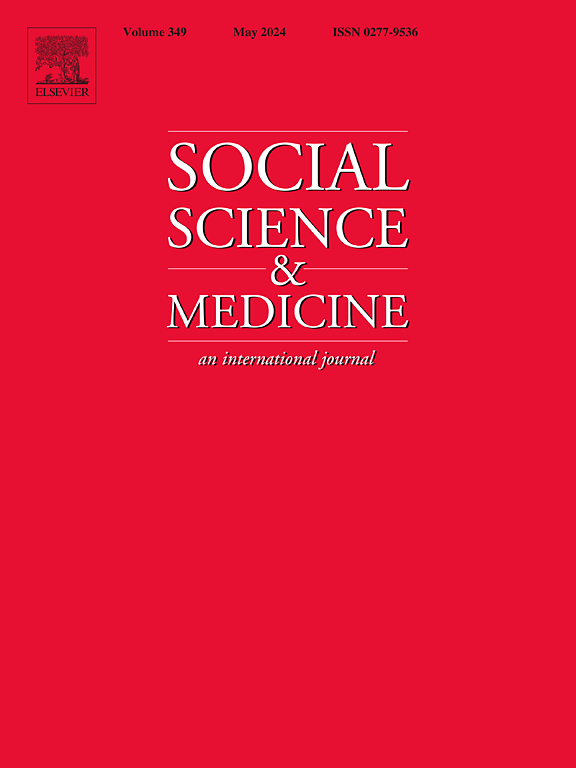“当我们痛苦时,我们不会停止作为土著居民”:对土著人民慢性疼痛生活经历的综合回顾
IF 4.9
2区 医学
Q1 PUBLIC, ENVIRONMENTAL & OCCUPATIONAL HEALTH
引用次数: 0
摘要
背景 慢性非癌症疼痛是全世界的主要负担。受长期殖民化的影响,包括系统性的种族主义、压迫和边缘化,土著社区在疼痛护理和管理方面经历着更多的不平等。在管理疼痛时,土著人重视传统的治疗知识、实践和方法。目的了解全球各地的原住民在经历慢性非癌症疼痛时是如何理解疼痛的。我们重点关注了经验性和理论性研究中患有慢性非癌症疼痛的土著成年人所报告的定性数据。除灰色文献外,我们还在 1990 年至 2023 年 8 月期间对健康和人文科学范围内的数据库进行了电子检索。我们借鉴了批判理论的方法,对所纳入研究的数据进行了专题分析,通过西方知识框架(两眼观察认识论)优先考虑土著观点。数据提取和主题分析采用 NVivo 软件进行管理。在去除重复数据后,我们使用标题和摘要筛选了 1352 项研究,并从中评估了 99 篇全文,最终纳入了 29 项研究和 3 篇论文/论文集。纳入的研究报告了大洋洲、北美洲和南美洲土著居民的慢性疼痛生活经历。专题分析得出了四个主要专题,表明疼痛与自然、土著身份、历史创伤和集体纠缠在一起。我们的研究结果表明,疼痛与情感、思想、民族和地方等更广泛的情景相互关联。由原住民主导的以文化安全护理为重点的替代方案可以指导临床疼痛实践方法,并有助于实现健康公平。本文章由计算机程序翻译,如有差异,请以英文原文为准。
“We do not stop being Indigenous when we are in pain”: An integrative review of the lived experiences of chronic pain among Indigenous peoples
Background
Chronic non-cancer pain is a major burden worldwide. Indigenous communities experience additional inequities in pain care and management influenced by long-standing impacts of colonization, including systemic racism, oppression, and marginalization. Traditional healing knowledges, practices and methods are valued by Indigenous people when managing their pain. However, mainstream health services often disregard this knowledge and fail to provide culturally safe management strategies.
Aim
To understand how Indigenous peoples across the globe make sense of pain when experiencing chronic non-cancer pain.
Methodology and methods
This integrative literature review is reported according to the PRISMA checklist and CONSIDER statement. We focused on qualitative data reported by Indigenous adults with chronic non-cancer pain in empirical and theoretical studies. Electronic searches were performed in databases from health and humanities scopes, in addition to grey literature, from 1990 to August 2023. We drew from critical theory approaches to thematically analyze data from the included studies, privileging Indigenous perspectives through a Western intellectual framework (Two-Eyed Seeing epistemology). Data extraction and thematic analysis were managed using NVivo. Primary data were mapped according to geography and theoretical framework.
Results
After removal of duplicates, 1352 studies were screened using title and abstract, from which 99 full texts were assessed and 29 studies and 3 dissertations/theses were included. Included studies reported lived experiences of chronic pain among Indigenous peoples from Oceania, North America, and South America. Thematic analysis derived four main themes that indicated pain is entwined with nature, Indigenous identity, historical trauma, and the collective. Our findings suggest that pain is interconnected to a broader scenario of feelings, thoughts, peoples and places.
Conclusion
Our findings highlight the layered and complex aspects of the lived experiences of chronic pain among Indigenous people. Indigenous-led alternatives focusing on culturally safe care can guide approaches to clinical pain practice and contribute to achieving health equity.
求助全文
通过发布文献求助,成功后即可免费获取论文全文。
去求助
来源期刊

Social Science & Medicine
PUBLIC, ENVIRONMENTAL & OCCUPATIONAL HEALTH-
CiteScore
9.10
自引率
5.60%
发文量
762
审稿时长
38 days
期刊介绍:
Social Science & Medicine provides an international and interdisciplinary forum for the dissemination of social science research on health. We publish original research articles (both empirical and theoretical), reviews, position papers and commentaries on health issues, to inform current research, policy and practice in all areas of common interest to social scientists, health practitioners, and policy makers. The journal publishes material relevant to any aspect of health from a wide range of social science disciplines (anthropology, economics, epidemiology, geography, policy, psychology, and sociology), and material relevant to the social sciences from any of the professions concerned with physical and mental health, health care, clinical practice, and health policy and organization. We encourage material which is of general interest to an international readership.
 求助内容:
求助内容: 应助结果提醒方式:
应助结果提醒方式:


